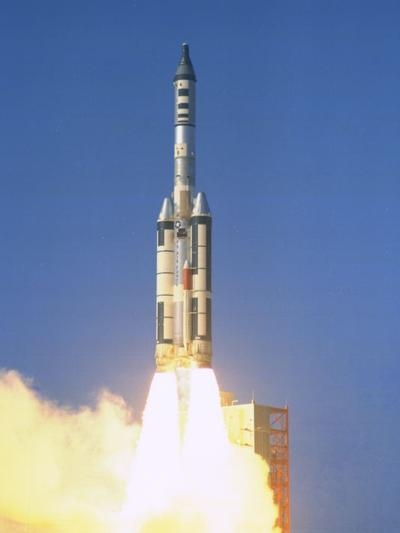Tue, Nov 08, 2016
But Manned Orbiting Laboratory Was A Short-Lived Idea
Last week, the U.S. Air Force celebrated the 50th anniversary of the only launch in the Manned Orbiting Laboratory (MOL) program. The November 3 flight would determine if a modified Gemini capsule could survive re-entry after a hatch had been cut into its heat shield.

The hatch would have allowed astronauts to move between the capsule and a planned laboratory situated below.
While the capsule survived the 33 minute suborbital flight, the program did not.
Florida today reports that the program was cancelled less than three years later in 1969.
But the capsule is a one-of-a-kind artifact. It is the only Mercury, Gemini, or Apollo capsule ever to fly into space twice. It was also the only capsule to fly in space carrying U.S. Air Force markings.
According to the National Reconnaissance Office, The Manned Orbiting Laboratory (MOL) was a 1960s Air Force program with the ostensible mission to place military personnel in orbit to conduct scientific experiments to determine the “military usefulness” of placing man into space and the techniques and procedures for doing so if the need ever arose. The actual, classified, mission of the MOL program was to place a manned surveillance satellite into orbit. At the time, several military and contractor studies estimated that manned surveillance satellites could acquire photographic coverage of the Soviet Union with resolution better than the best system at the time (the first generation Gambit satellite). Additionally, the Air Force billed the MOL as a reconnaissance system that could more efficiently and quickly adjust coverage for crises and targets of opportunity than unmanned systems. The Air Force controlled development of the satellite, which was consistent with MOL’s unclassified
mission, while the NRO ran development of the covert reconnaissance mission of the program, including the camera system and other subsystems.
The MOL-B test flight came less than 10 years after the Soviets launched Sputnik and sparked the space race. But satellite technology advanced quickly, and made a manned program unnecessary.
(NASA Image)
More News
From 2021: The Inside Skinny On What Being An ANN Oshkosh Stringer Is All About By ANN Senior Stringer Extraordinare, Gene Yarbrough The annual gathering at Oshkosh is a right of p>[...]
Video Showed That During The Takeoff, The Nose Baggage Door Was Open On May 10, 2025, about 0935 eastern daylight time, a Piper PA-32RT-300, N30689, was destroyed when it was invol>[...]
Get The Latest in Aviation News NOW on Instagram Are you on Instagram yet? It's been around for a few years, quietly picking up traction mostly thanks to everybody's new obsession >[...]
"I think what is key, we have offered a bonus to air traffic controllers who are eligible to retire. We are going to pay them a 20% bonus on their salary to stay longer. Don't reti>[...]
Aero Linx: Pilot Briefing The gathering, translation, interpretation, and summarization of weather and aeronautical information into a form usable by the pilot or flight supervisor>[...]
 Oshkosh Memories: An Aero-News Stringer Perspective
Oshkosh Memories: An Aero-News Stringer Perspective NTSB Prelim: Piper PA32RT
NTSB Prelim: Piper PA32RT ANN FAQ: Follow Us On Instagram!
ANN FAQ: Follow Us On Instagram! Aero-News: Quote of the Day (05.28.25)
Aero-News: Quote of the Day (05.28.25) ANN's Daily Aero-Term (05.28.25): Pilot Briefing
ANN's Daily Aero-Term (05.28.25): Pilot Briefing



